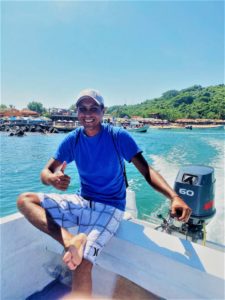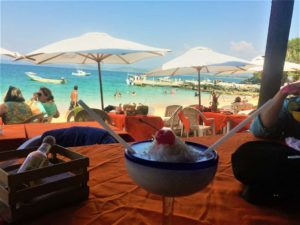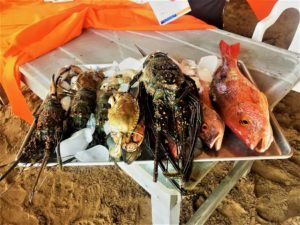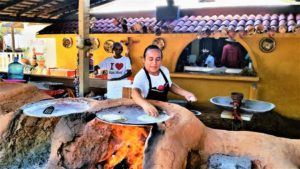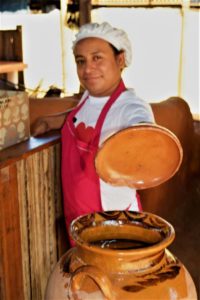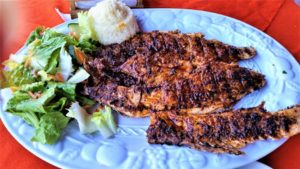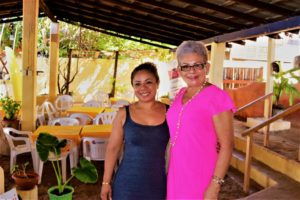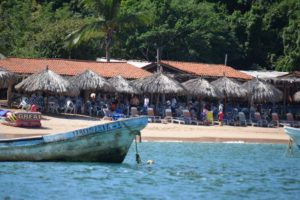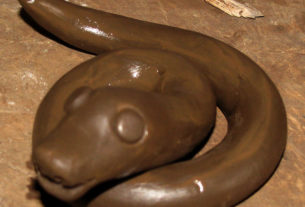Greg knows the old way—or so he says—but all I can see is an empty stretch of sand and water where the southern tip of Playa Quieta ends at a rocky outcropping of rocks jutting out into the Bahia de Palmar.
When I lived here, he explains, this is where we caught the pangas going to and from Isla de Ixtapa. Pangas are water taxis, propelled by outboard motors, that transport passengers the eight miles or so from the Ixtapa mainland to the island.
Of course, I think, Greg’s time here was years ago and now most tourists start this trip at the pier at Playa Linda, the main beach for swimming and snorkeling and the one where the crocodile sanctuary is located.
This is easier, Greg says, than going all the way into town. And indeed, if this is still a panga stop, it is just a short walk from the hotel where we’re all staying.
As I’m pointing out that there’s no signage (I’m still thinking like a city gal looking for a bus stop), the first panga arrives. As the motor is cut and it slows to a stop, I see even more boats coming up behind. Turning, I realize there are people along the shoreline towards us. It all makes me wonder if there’s a panga schedule that everyone knows but no one told me about.
It’s a wet embarkation, but then it is a beach after all.
I wade through the water to a waiting boatman who takes my bag and shoes and helps me up the ladder. Within 15 minutes of the engine starting back up, we dock at a jetty built of uneven stones edged by thick vegetation on one side and the sandy expanse of Playa Varadero on the other. The beach is crowded with restaurants, each covering a narrow strip of land stretching from Playa Varadero to Coral Beach, the volcanic stone-strewn cove on the other side of the island known for its excellent snorkeling. The restaurants all look somewhat alike to me—thatched roofs, plastic chairs surrounding metal tables and bars with large blenders buzzing almost constantly as ice and mangos, papayas and other fruits are pureed into margaritas and piña coladas.
We look hungrily at a tray of salt-rimmed margaritas, but we can’t stop. We’re on our way to Lili Cipriani. The name intrigues me, sounding like a Parisian café but it’s definitely a beach sort of place. Scattered around the large kitchen that takes center stage are busy workers shucking oysters from large net bags still dripping wet from the waters of the bay; others pat masa into round thin circles, flipping them onto large flat top griddles balanced above burning logs, while someone else stirs a large pot of beans suspended from a tripod over open flames.
All this old fashioned cookery isn’t just for show. There’s no electricity on the island, so propane and wood are shipped aboard pangas each morning, as are all other ingredients needed for a day’s worth of cooking. Everything that is but the seafood, which is hooked in the surrounding waters and then displayed on trays so diners can choose from such freshly caught items as lobster, shrimp, crabs, and red snapper. Pick out what you want, and it’s cooked the way you want it. Can’t really get much fresher than that!
Beyond the kitchen and the bar, Lili Cipriani is a one-stop shop—artisans sit in the shade, painting delicate patterns on the pottery sold in their store alongside sunscreen, sunglasses, and other beach necessities. Snorkeling equipment can be bought or rented. Massages, the real kind, are available upstairs. Vendors sell jewelry, ironwood carvings and exquisitely hand-embroidered blouses. Pass through here and you’re on Coral Beach but still at Lili Cipriani’s. Coral Beach is all jagged shoreline topped by huge stick cactus and the inky black outlines of volcanic rocks—a huge difference to the gentle waters of Playa Varadero where boats bob in the waters and families swim in the cove.
No matter which side you choose, it’s the ultimate in beach casual—sand for floors, the crash of waves sometimes covering the feet of diners whose tables are too near the shore, and bougainvillea flowers dropping onto tables and into beach bags. Indeed, this casualness extends to their seemingly inefficient way of keeping track of orders. It’s not that we don’t get the food we order, we do, but when we decide to migrate from one beach to the other and try to pay up, the server waves us off in a catch you later gesture. How do they know we aren’t going to board a panga and leave? It’s not like we’re the only people here, there must be at least a 100 or so diners and swimmers. I later learn the restaurant can accommodate about 300 or so.
Food and drinks are brought to us as they come out of the kitchen, but the servers never seem to write anything down. Cervezas are delivered to tables in large pails of ice. Empty beer bottles, turned upside down, are placed back in the pail, When only bottoms are showing, it’s taken away and the charges put on your bill. That is, if you can get a bill. Trying to check out, I go looking for our server and end up at the desk where Lili Pineda—the Lili of Lili Cipriani—is sitting.
It’s hot, my hair is frizzy, my beach cover up has a splash or two of hot sauce decorating it and I’m coated with a fine layer of salt and sand from swimming—my most strenuous activity because for the most part, I’ve just been eating and drinking.
Pineda is just the opposite—despite the crowds of diners and the whirlwind of her staff asking countless questions, she’s poised and calm. Her hair is immaculately coiffed, her make-up and nails perfect and she’s wearing—honestly—a tight fitting and very flattering dress and high heels. Her finishing touches are expensive gold earrings with matching bracelets and necklace. I am wearing a “pearl” necklace I bought on the beach the night before for $8. It seemed, at the time, like a great buy but of course it pales next to Lili’s jewelry.
Standing next to her, equally cool, and dressed in the same sophisticated style, is her daughter, Jessica Zamudio Pineda.
They are, of course, gracious, and yes, their English is much better than my Spanish. Our bill is quickly found, I pay and then decide I really really need an extra order of freshly shucked oysters to take with me.
But is there time? I ask, seeing my group gathering their beach gear, some already heading to the jetty where the next panga is due shortly—really I must find this mysterious panga schedule.
Beyond glamour, mother and daughter are amazingly efficient as well. Of course there’s time, they tell me and quickly my order is placed. A young man begins prying open oyster shells discarding the empty shells into a towering stack. Seeing me anxiously glancing at my group, Lili says something in a quiet voice and another shucker joins him. Within minutes I have my bag of oysters and am running through the sand where the panga waits.
- Contact Lili Cipriani Restaurant Bar by phone 755- 120-0404 or Facebook

